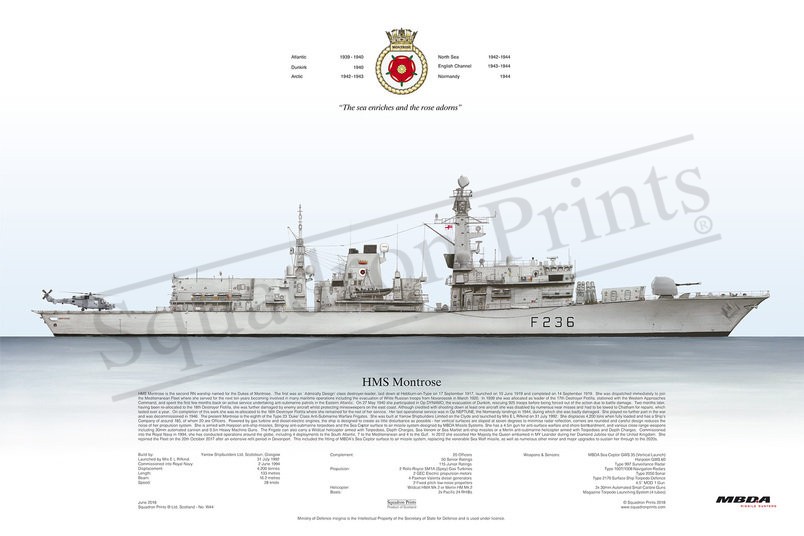#W44 Type 23 Frigate, HMS Montrose F236 print

Description
Squadron Prints Lithograph No. W44 - HMS Montrose
HMS Montrose is the second RN warship named for the Dukes of Montrose. The first was an `Admiralty Design’ class destroyer-leader, laid down at Hebburn-on-Type on 17 September 1917, launched on 10 June 1919 and completed on 14 September 1919. She was dispatched immediately to join the Mediterranean Fleet where she served for the next ten years becoming involved in many maritime operations including the evacuation of White Russian troops from Novorossisk in March 1920. In 1939 she was allocated as leader of the 17th Destroyer Flotilla, stationed with the Western Approaches Command, and spent the first few months back on active service undertaking anti-submarine patrols in the Eastern Atlantic. On 27 May 1940 she participated in Op DYNAMO, the evacuation of Dunkirk, rescuing 925 troops before being forced out of the action due to battle damage. Two months later, having been re-allocated to the 18th Destroyer Flotilla, she was further damaged by enemy aircraft whilst protecting minesweepers on the east coast. Although credited with shooting down at least one aircraft she was disabled by numerous near misses and had to be towed to Chatham for repairs, which lasted over a year. On completion of this work she was re-allocated to the 16th Destroyer Flotilla where she remained for the rest of her service. Her last operational service was in Op NEPTUNE, the Normandy landings in 1944, during which she was badly damaged. She played no further part in the war and was decommissioned in 1946. The present Montrose is the eighth of the Type 23 ‘Duke’ Class Anti-Submarine Warfare Frigates. She was built at Yarrow Shipbuilders Limited on the Clyde and launched by Mrs E L Rifkind on 31 July 1992. She displaces 4,200 tons when fully loaded and has a Ship’s Company of around 185, of whom 20 are Officers. Powered by gas turbine and diesel-electric engines, the ship is designed to create as little disturbance as possible - her vertical surfaces are sloped at seven degrees to minimise radar reflection, corners are rounded and careful design reduces the noise of her propulsion system. She is armed with Harpoon anti-ship missiles, Stingray anti-submarine torpedoes and the Sea Ceptor surface to air missile system designed by MBDA Missile Systems. She has a 4.5in gun for anti-surface warfare and shore bombardment, and various close range weapons including 30mm automated cannon and 0.5in Heavy Machine Guns. The Frigate can also carry a Wildcat helicopter armed with Torpedoes, Depth Charges, Sea Venom or Sea Martlet anti-ship missiles or a Merlin anti-submarine helicopter armed with Torpedoes and Depth Charges. Commissioned into the Royal Navy in 1994, she has conducted operations around the globe, including 4 deployments to the South Atlantic, 7 to the Mediterranean and 4 to the Gulf. In 2012 she escorted Her Majesty the Queen embarked in MY Leander during her Diamond Jubilee tour of the United Kingdom. She rejoined the Fleet on the 20th October 2017 after an extensive refit period in Devonport. This included the fitting of MBDA’s Sea Ceptor surface to air missile system, replacing the venerable Sea Wolf missile, as well as numerous other minor and major upgrades to sustain her through to the 2020s.
You may also like
-
Tornado GR4
ZG75016 Sqn; 12 Sqn; 15 Sqn; 617 Sqn; 13 Sqn; 31 Sqn; 20 Sqn; 2 Sqn; 17 Sqn; 27 Sqn; 9 SqnRAF Lossiemouth; RAF Marham -
40th FLTS A-10C, F-16C and F-15EX print
88-0441; 79-0177; 20-000140 FLTS; 96 TWEglin AFB, Florida
